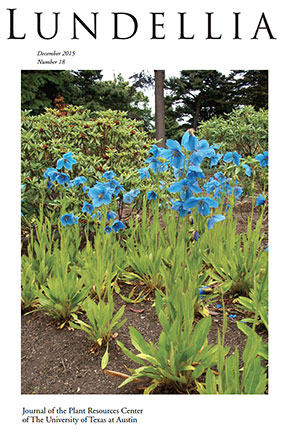
Journal of the Plant Resources Center of the University of Texas at Austin
Number 18 — December 2015
[Published: 9 December 2015]
Contents:
Taxonomic Utility of Lemma Micromorphological Characters in the
Sporobolus compositus and
Sporobolus vaginiflorus Complexes (Poaceae)
Robert T. Harms & John Mendenhall
View Abstract — Download article (28 MB)
Abstracts
Taxonomic Utility of Lemma Micromorphological Characters in the Sporobolus compositus and Sporobolus vaginiflorus Complexes (Poaceae)
Robert T. Harms & John Mendenhall
1—9
Abstract: Five lemma micromorphological characters including bicellular microhairs, hooks, long cells, prickles, and silica cells of six Sporobolus taxa representing the S. compositus and S. vaginiflorus complexes in Texas were investigated using scanning electron microscopy (SEM). Our study supplements earlier SEM treatments of Sporobolus in Valdés-Reyna & Hatch and Liu et al. and colleagues. The micromorphological differences found by our study support the taxonomic treatment of these two complexes by Peterson et al...
Verbesina tiburonensis (Asteraceae: Heliantheae), A New Species from Isla Tiburón, Gulf of California, Mexico
Billie L. Turner
10—13
Abstract: Verbesina tiburonensis is a new species from Isla Tiburón, Sonora, Mexico. It is closely related to Verbesina palmeri and V. oligocephala both native to Baja California.
Phylogenetic Analysis of Meconopsis (Papaveraceae) and Evaluation of Two Controversial Taxonomic Species
Wei Xiao & Beryl B. Simpson
14—27
Abstract: Meconopsis is a genus native to the high elevation habitats that range from the western Himalaya eastward to the Hengduan Mountains (China). The genus has been the subject of several taxonomic treatments and monographs by generations of botanists, which resulted in a long and confusing taxonomic history resulting from inconsistent species concepts and conflicting interpretations of relationships among named taxa. In the present study, we reconstructed the evolutionary history of Meconopsis utilizing four chloroplast markers (rbcL, matK, ndhF and the trnL-trnF intergenic spacer) and the nuclear ribosomal internal transcribed spacer (nrITS). Incongruence found between the cpDNA and nrITS trees was investigated to detect reticulate evolution, using the approximately unbiased (AU) method. Based on the evolutionary patterns revealed by our resultant phylogenies, we evaluated the species delimitations of the two most controversial “species” (Meconopsis horridula and Meconopsis napaulensis) in the genus and the inconsistency among their previously published treatments. As a result, we provide taxonomic suggestions for these species that include the proposal of a M. horridula species complex.
 Lundellia Home Page
Lundellia Home Page
U. Texas at Austin | Biological
Sciences | Plant Resources Center | Contact Us

